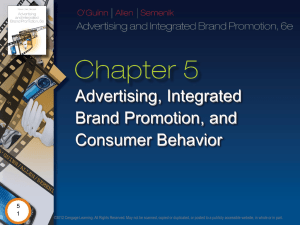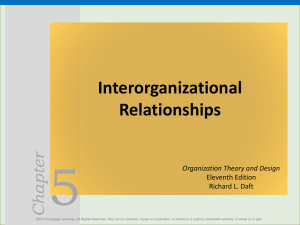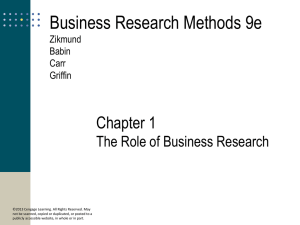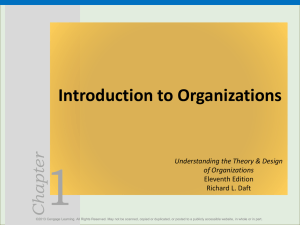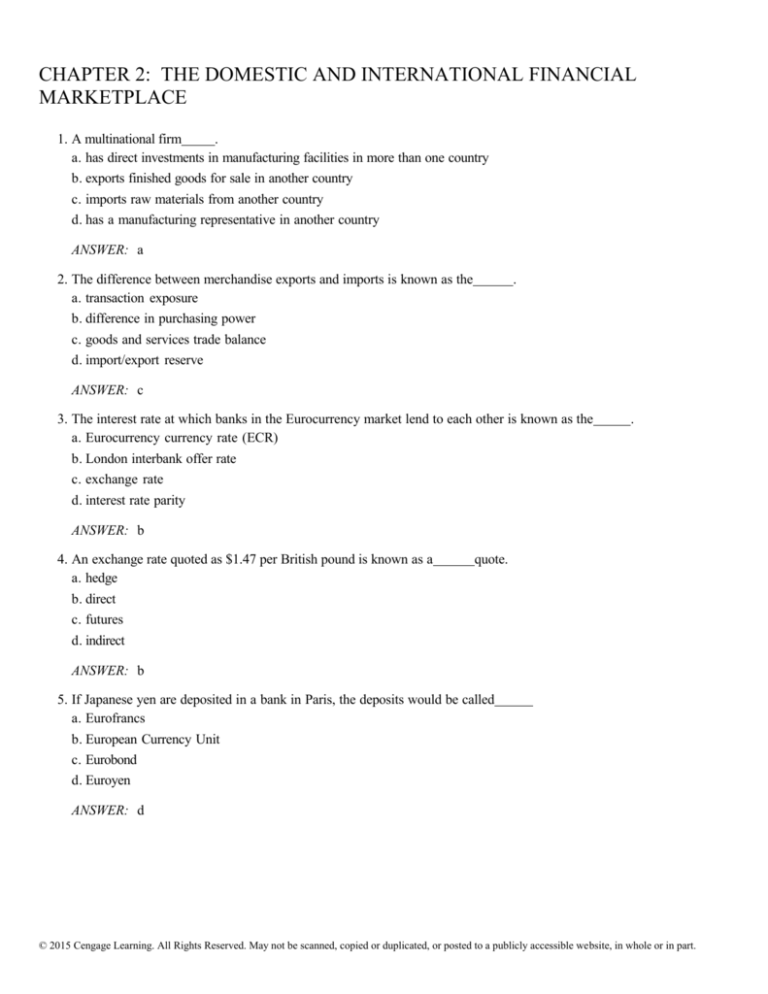
CHAPTER 2: THE DOMESTIC AND INTERNATIONAL FINANCIAL
MARKETPLACE
1. A multinational firm
.
a. has direct investments in manufacturing facilities in more than one country
b. exports finished goods for sale in another country
c. imports raw materials from another country
d. has a manufacturing representative in another country
ANSWER: a
2. The difference between merchandise exports and imports is known as the
a. transaction exposure
.
b. difference in purchasing power
c. goods and services trade balance
d. import/export reserve
ANSWER: c
3. The interest rate at which banks in the Eurocurrency market lend to each other is known as the
a. Eurocurrency currency rate (ECR)
b. London interbank offer rate
c. exchange rate
d. interest rate parity
.
ANSWER: b
4. An exchange rate quoted as $1.47 per British pound is known as a
a. hedge
b. direct
c. futures
d. indirect
quote.
ANSWER: b
5. If Japanese yen are deposited in a bank in Paris, the deposits would be called
a. Eurofrancs
b. European Currency Unit
c. Eurobond
d. Euroyen
ANSWER: d
© 2015 Cengage Learning. All Rights Reserved. May not be scanned, copied or duplicated, or posted to a publicly accessible website, in whole or in part.
Chapter 2: The Domestic and International Financial Marketplace
6. If the spot rate for Swiss francs is $0.6658/franc and the 180-day forward rate is $0.6637, the market is
indicating that the Swiss franc is expected to
a. strengthen relative to the dollar
b. weaken relative to the ECU
c. lose value relative to the dollar over the next 6 months
d. gain value relative to the dollar over the next 6 months
ANSWER: c
7. Which of the following is not a correct statement about foreign currency futures?
a. futures contracts have a standardized maturity date
b. futures contracts are an exchange-traded agreement
c. futures contracts are not liquid
d. futures contracts are "marked to market" daily
ANSWER: c
8. The most important foreign currency futures market in the United States is the
a. Chicago Board of Trade
b. New York Mercantile Exchange
c. Commodity Exchange
d. Chicago Mercantile Exchange
.
ANSWER: d
9. The buyer of a foreign currency call option has the
a. right to sell
b. right but not the obligation to buy
c. obligation to buy, only at expiration,
d. obligation to buy
a fixed amount of a foreign currency.
ANSWER: b
10. Eurodollars are U.S. dollars that have been deposited in
a. foreign banks
b. foreign branches of U.S. banks
c. foreign subsidiaries
d. foreign banks and foreign branches of U.S. banks
ANSWER: d
© 2015 Cengage Learning. All Rights Reserved. May not be scanned, copied or duplicated, or posted to a publicly accessible website, in whole or in part.
Chapter 2: The Domestic and International Financial Marketplace
11. If the exchange rate from U.S. dollars to Canadian dollars is $0.80/Canadian dollar, then the exchange rate
from Canadian dollars to U.S. dollars is
a. 0.80 Canadian $/US dollar
b. $1.25 Canadian $/US dollar
c. $1.20 Canadian $/US dollar
d. $8.00 Canadian $/US dollar
ANSWER: b
12. If the exchange rate from U.S. dollars to Swiss francs is $0.20/franc, then the exchange rate from francs to
dollars is
a. 0.20 francs/dollar
b. 0.80 francs/dollar
c. 5.0 francs/dollar
d. 2.0 francs/dollar
ANSWER: c
13. If the spot rate (in U.S. dollars) for Japanese Yen is 0.00703 and the 180 day forward rate is 0.00717, then
the Yen is trading at a(n) .
a. expected gain
b. premium
c. reciprocal
d. discount
ANSWER: b
14. If the forward (direct quote) exchange rate is lower than the spot rate, then the currency is said to be
trading at a _____.
a. forward premium
b. forward gain
c. forward discount
d. forward loss
ANSWER: c
15. Financial middlemen include
a. securities brokers
b. securities dealers
c. investment bankers
d. all of these
ANSWER: d
© 2015 Cengage Learning. All Rights Reserved. May not be scanned, copied or duplicated, or posted to a publicly accessible website, in whole or in part.
Chapter 2: The Domestic and International Financial Marketplace
16. The following are listed security exchanges in the United Sates:
a. New York Stock Exchange
b. Pacific Exchange
c. Cincinnati Exchange
d. All of these are listed exchanges
ANSWER: d
17. The Standard and Poor's 500 Stock Price Index is a
a. price weighted
b. market value weighted
c. price average
d. none of these answers is correct
index.
ANSWER: b
18. Securities not listed on exchanges are said to be traded
a. on the AMEX
b. as composite transactions
c. over the counter
d. on the regional exchanges
ANSWER: c
19. Financial intermediaries include
a. securities brokers
b. commercial banks
c. securities dealers
d. all of these
ANSWER: b
20.
markets deal in long-term securities having maturities greater than one year.
a. Credit
b. Money
c. Commodity futures
d. Capital
ANSWER: d
21.
markets deal in short-term securities having maturities of one year or less.
a. Credit
b. Money
c. Capital
d. Capital and credit
ANSWER: b
© 2015 Cengage Learning. All Rights Reserved. May not be scanned, copied or duplicated, or posted to a publicly accessible website, in whole or in part.
Chapter 2: The Domestic and International Financial Marketplace
22. Which of the following (if any) are not financial intermediaries?
a. commercial bank
b. thrift institution
c. securities broker
d. all are financial intermediaries
ANSWER: c
23. In the
market, the firm receives the proceeds from the sale of its securities.
a. over-the-counter
b. secondary
c. fully integrated
d. primary
ANSWER: d
24. A savings and loan association is an example of which type of financial intermediary?
a. commercial bank
b. investment company
c. finance company
d. thrift institution
ANSWER: d
25. In any economy as a whole, the actual savings for a given period of time must
investments.
a. be greater than
b. be unrelated to
c. equal
d. be less than
the actual
ANSWER: c
26. Financial intermediaries
a. issue secondary claims to the lender
b. are compensated for their services by fixed fees
c. include both brokers and dealers
d. issue primary claims to the lender
ANSWER: a
27. The main purpose of an economy's financial system is to facilitate the transfer of funds from
a. financial middlemen to financial intermediaries
b. surplus spending units to deficit spending units
c. primary claimholders to secondary claimholders
d. lenders to financial intermediaries
ANSWER: b
© 2015 Cengage Learning. All Rights Reserved. May not be scanned, copied or duplicated, or posted to a publicly accessible website, in whole or in part.
Chapter 2: The Domestic and International Financial Marketplace
28. Money markets deal in securities having maturities of
a. less than 18 months, greater than 18 months
; capital market securities have maturities
.
b. one year or less, greater than one year
c. less than 9 months, greater than 9 months
d. less than 6 months, greater than 6 months
ANSWER: b
29. Commercial banks are an important source of
a. mortgage loans
b. equity loans
c. real estate loans
d. short-term loans and term loans
ANSWER: d
30. Finance companies obtain a significant amount of their funds by
a. issuing their own equity securities
b. accepting both demand and time deposits
c. issuing their own debt securities
d. pooling funds
ANSWER: c
31. When an investor purchases shares in a no-load common stock mutual fund, she is using a(n)
a. primary intermediary
b. financial intermediary
c. over-the-counter market
d. broker
ANSWER: b
32. The interest rate in the Eurodollar market is related to
a. the DOW
b. the stock market
c. the LIBOR
d. interest rates in the United States
ANSWER: c
33. Capital markets in financially sophisticated economies are not perfectly efficient because of
a. anomalous events
b. the Sun Spot theory
c. irrational investor behavior
d. anomalous events and irrational investor behavior
ANSWER: d
© 2015 Cengage Learning. All Rights Reserved. May not be scanned, copied or duplicated, or posted to a publicly accessible website, in whole or in part.
Chapter 2: The Domestic and International Financial Marketplace
34. Commercial banks are a major source of term loans. These loans are best used for:
a. financing the expansion of the business.
b. financing the establishment of overseas operations.
c. financing current assets like inventory and accounts receivable.
d. financing the payment of dividends.
ANSWER: c
35. The Dow Jones Industrial Average is calculated using the
a. total market value of 30 stocks
b. price of 30 stocks
c. a weighted index of 30 stocks
d. industrial, railroad, financial, and utility stocks
ANSWER: b
36. Insider trading is defined as
a. an individual using proper trading rules
b. an individual buying or selling using non-SEC disclosure rules
c. an individual buying or selling on the basis of material nonpublic information
d. a zero-plus game
ANSWER: c
37. The U.S. financial markets are said to be highly informationally efficient. This means
a. they process stock trades accurately and quickly
b. the market provides quick access to a firm's financial statements
c. they quickly reflect information relevant to determining stock value
d. accurate stock quotes are quickly available to all investors
ANSWER: c
38. Ex post returns differ from
a. ex ante; estimated; actual
returns in that they represent
values rather than
values.
b. ex post; accounting; economic
c. ex ante; actual; estimated
d. ex ante; economic; accounting
ANSWER: c
39. The fact that no investor can expect to earn excess returns based on an investment strategy using only
historical stock price or return information is an example of market efficiency.
a. strong-form
b. weak-form
c. semiweak-form
d. semistrong-form
ANSWER: b
© 2015 Cengage Learning. All Rights Reserved. May not be scanned, copied or duplicated, or posted to a publicly accessible website, in whole or in part.
Chapter 2: The Domestic and International Financial Marketplace
40. With semistrong-form market efficiency, no investor can expect to earn excess returns based on an
investment strategy using any
information.
a. past market price
b. market value
c. publicly available
d. private
ANSWER: c
41. In an efficient capital market, all security investments will have:
a. a required rate of return that exceeds the cost of capital
b. a positive NPV
c. a required rate of return that is zero
d. a NPV of zero
ANSWER: d
42. In an efficient capital market, corporate diversification is
a. unnecessary
b. inexpensive
c. of benefit to corporate managers
d. of great benefit
.
ANSWER: a
43. The barriers to the free flow of capital among the major world capital markets include all of the following
except:
a. low transaction costs
b. taxation policies
c. foreign exchange risks
d. legal restrictions
ANSWER: a
44. For the financial manager, taxes have important implications for
a. dividend policy
b. financial restructurings
c. capital structure policy
d. all of these
ANSWER: d
© 2015 Cengage Learning. All Rights Reserved. May not be scanned, copied or duplicated, or posted to a publicly accessible website, in whole or in part.
Chapter 2: The Domestic and International Financial Marketplace
45. Changes in the tax code that slow down depreciation,
and, therefore, make the investment desirable.
a. decrease, more
the present value of investment cash flows
b. decrease, less
c. increase, more
d. increase, less
ANSWER: b
46. In an efficient capital market
a. required returns equal expected returns
b. investors will have holding period returns equal to zero
c. purchase of any security yields zero profit
d. purchasing stocks is no better than gambling
ANSWER: a
47. If the spot rate for the British pound is $1.5077 and the 180-day forward rate is $1.4934, what is the
annualized premium (discount)?
a. premium of 1.90%
b. premium of 0.97%
c. discount of (-)1.90%
d. discount of (-)0.97%
ANSWER:
c
RATIONALE: Solution: [($1.4934 - $1.5077)/($1.5077)](12/6)(100%) = -1.897%
48. If the spot rate for the Japanese yen is $0.009204 and the 90-day forward rate is $0.009227, what is the
annualized premium (discount)?
a. premium of 1.00%
b. premium of 0.50%
c. discount of -0.99%
d. premium of 0.25%
ANSWER:
a
RATIONALE: Solution: [(.009227 - .009204)/(.009204)](12/3)(100%) = 0.9996%
49. Christy purchased 100 shares of Good Idea stock for $48 last year. Yesterday she sold the stock for $45. If
she received $4 in dividends during the time she held the security, what is her holding period return?
a. 2.08%
b. 8.30%
c. -6.30%
d. 14.60%
ANSWER:
a
RATIONALE: Solution: ($45 - $48 + $4)/$48 = 0.0208 or 2.08%
© 2015 Cengage Learning. All Rights Reserved. May not be scanned, copied or duplicated, or posted to a publicly accessible website, in whole or in part.
Chapter 2: The Domestic and International Financial Marketplace
50. If an investor purchased 100 shares of Biggee stock for $30 per share, 6 months ago, and then sold the
stock today for $33 per share, what was the investor's holding period return if a total of $1 per share in
dividends was received over the 6 month period?
a. 10%
b. 27.1%
c. 17.1%
d. 13.3%
ANSWER:
d
RATIONALE: Solution: HPR = ($33 - $30 + $1)/$30 = 13.3%
51. What is the holding period return to an investor who bought 100 shares of Oil Slick stock nine months ago
for $36 per share, received two $50 dividend checks, and sold the stock today at $38 a share.
a. 5.56%
b. 8.33%
c. 11.11%
d. 6.94%
ANSWER:
b
RATIONALE: Solution: ($38 + $1 - $36)/$36 = 0.0833 or 8.33%
52. If a treasury bond can be purchased for $9,450 today and the bond holder will receive $850 in interest and the
$10,000 face value at maturity, what is the percentage holding period return?
a. 14.8%
b. 5.8%
c. 6.7%
d. 12.6%
ANSWER:
a
RATIONALE: Solution: ($10,000 - $9,450 + $850)/$9,450 = 0.148 or 14.8%
53. You bought 100 shares of Risky Venture stock six months ago for $14 per share and sold it yesterday for
$12. The company paid a total of $0.24 per share in dividends to you during the time you held the stock.
What was your holding period return?
a. -25.14%
b. -16.67%
c. -12.57%
d. 16.00%
ANSWER:
c
RATIONALE: Solution: HPR = ($12 - $14 + $0.24)/$14 = -0.1257 or -12.57%
© 2015 Cengage Learning. All Rights Reserved. May not be scanned, copied or duplicated, or posted to a publicly accessible website, in whole or in part.
Chapter 2: The Domestic and International Financial Marketplace
54. Maher purchased 100 shares of Chill Pill Pharmaceuticals at $30 per share last spring and sold them in six
months for $36 per share. The stock paid no dividend. What was Maher's holding period return?
a. 40%
b. 20%
c. 10%
d. 5%
ANSWER:
b
RATIONALE: Solution: HPR = (3600 - 3000)/3000 × 100% = 20%
55. Two years ago you bought 100 shares of Big Bubba convertible preferred stock at $25 per share. The
preferred stock had an annual dividend of $2.125 per share, and a total of $3.19 in dividends per share have
been paid so far. Today the company announced that the stock is redeemable for $26.70 plus accrued and
unpaid dividends, for a total of $27.76. Alternatively, holders may convert their shares of preferred stock at a
conversion rate of 1.6393 shares of Big Bubba common stock for each share of preferred stock. If the closing
price of Big Bubba common stock is $27.50, what is your holding period return?
a. 93.08%
b. 23.80%
c. 80.32%
d. 64.60%
ANSWER:
a
RATIONALE: Solution: Ending price = $27.50(1.6393) = $45.08
HPR = ($45.08 - $25 + $3.19)/$25 = 0.9308 or 93.08%
56. If the spot rate (in U.S. dollars) for Japanese Yen is 0.00703 and the 180 day forward rate is 0.00717, then
the Yen is trading at an annualized
a. premium of 4.04%
b. premium of 3.98%
c. premium of 3.91%
d. discount of 3.89%
ANSWER:
b
RATIONALE: Solution: Premium = [(0.00717 - 0.00703)/0.00703](12/6) = 0.0398
57. Lear purchased 100 shares of Quitcha Twitchin Anti-inch Cream stock at $30 per share last year and sold
them eleven months later for $24 per share. The shares split 2 for 1 shortly after Lear purchased the stock.
If the stock paid $0.25 per share in dividends last year, what is Lear's holding period return?
a. 61.67%
b. -19.17%
c. 21.67%
d. 6.17%
ANSWER:
a
RATIONALE: Solution: HPR = [2400 - 1500 + .25(100)]/1500 × 100% = 61.67%
© 2015 Cengage Learning. All Rights Reserved. May not be scanned, copied or duplicated, or posted to a publicly accessible website, in whole or in part.
Chapter 2: The Domestic and International Financial Marketplace
58. Which of the following reflect (reflects) the implications of income taxes for financial managers:
I. Interest payments on debt incurred by the firm are not tax deductible for the firm.
II. Preferred stock and common stock dividends are tax deductible for the firm and are used as often
as possible to raise capital.
a. Only statement I is correct.
b. Only statement II is correct.
c. Both statements I and II are correct.
d. Neither statement I nor II is correct.
ANSWER: d
59. Savings and loan associations are considered:
a. commercial banks
b. investment companies
c. thrift institutions
d. loan sharks
ANSWER: c
60. Which of the following is correct regarding the forms of market efficiency?
I. In an efficient capital market stock prices provide an unbiased estimate of the true value of an
enterprise.
II. In an efficient capital market, stock prices reflect the present value of the firm’s expected cash
flows.
a. Only statement I is correct
b. Only statement II is correct
c. Both statements I and II are correct
d. Neither statement I nor II is correct
ANSWER: c
61. Which of the following statements is/are correct about financial intermediaries?
I. Financial intermediaries primarily operate within the secondary market.
II. Examples of financial intermediaries are: commercial banks, thrift companies and the internal
revenue service.
a. Only statement I is correct.
b. Only statement II is correct.
c. Both statements I and II are correct.
d. Neither statement I nor II is correct.
ANSWER: d
© 2015 Cengage Learning. All Rights Reserved. May not be scanned, copied or duplicated, or posted to a publicly accessible website, in whole or in part.
Chapter 2: The Domestic and International Financial Marketplace
62. There are three forms of market efficiency. All of the following statements are correct EXCEPT:
a. The weak form efficiency states that no investor can earn excess returns based on historical price
information.
b. The strong form of efficiency states that no investor can consistently earn excess returns since all public
and private information is reflected in stock prices.
c. The semi-strong form of efficiency states that no investor can earn excess returns based on an
investment strategy using public information.
d. Market efficiency is a hard and fast rule that has been verified in real-world situations.
ANSWER: d
63. There are highly publicized hedge fund problems, for example Julian Robertson’s Tiger fund or Long Term
Capital Management. The impact that this has had on hedge funds is:
a. minimal. They have continued to grow in size and number.
b. huge. Hedge funds are being discontinued.
c. being felt in the overall reallocation of hedge funds into bonds.
d. inconsequential and irrelevant. Investors may rely on the due diligence of the fund managers for safe
investing.
ANSWER: a
64. An example of a financial middleman is a:
a. commercial bank
b. stock broker
c. insurance company
d. thrift institution
ANSWER: b
65. An example of a listed security exchange within the secondary market is:
a. OTC
b. NYSE
c. NASDAQ
d. Automated quotations
ANSWER: b
66. As a group, net savers are:
a. businesses
b. households
c. government
d. partnerships
ANSWER: b
© 2015 Cengage Learning. All Rights Reserved. May not be scanned, copied or duplicated, or posted to a publicly accessible website, in whole or in part.
Chapter 2: The Domestic and International Financial Marketplace
67. Trading on the NYSE is conducted by members of the exchange. The members that execute orders and
act as agents on behalf of their clients are:
a. Floor Brokers
b. Exchange Runners
c. Designated Market Makers
d. SEC Agents
ANSWER: a
68. The difference between the bid price and the ask price on a security is the:
a. spread
b. value
c. asset factor
d. commission
ANSWER: a
69. There are many reasons why there was a financial crisis in 2007. The most significant event closely
associated with this crisis is:
a. the stock market crash
b. the real estate bubble
c. government overspending
d. the use of financial hedging
ANSWER: b
70. In the financial crisis of 2007 there was cheap money coming from emerging markets. Examples of
emerging markets are all of the following EXCEPT:
a. South Korea
b. Australia
c. India
d. China
ANSWER: b
71. Although there was a financial crisis in 2007-2010, some firms were able to weather the crisis. These firms
had all of the following characteristics which were directly responsible for their ability to survive the crisis
EXCEPT:
a. Tight control over fixed and variable costs
b. Low business risk
c. A business model which encouraged risk taking by management that paid off
d. Low product pricing
ANSWER: c
© 2015 Cengage Learning. All Rights Reserved. May not be scanned, copied or duplicated, or posted to a publicly accessible website, in whole or in part.
Chapter 2: The Domestic and International Financial Marketplace
72. What are the differences between the primary and secondary markets?
ANSWER: The primary market allows the investor to purchase new securities. Net proceeds from such
sales go to the issuing corporation.
The secondary market allows the investor to purchase securities that are already in circulation.
These are purchased through an organized security exchange, for example NYSE, or in the
over-the-counter market, and none of the proceeds go to the issuing corporation.
73. What is the purpose and importance of the stock market indexes?
ANSWER: Stock market indexes give a broad indication of how the stock market or a segment of it
performed during a particular day. The most known index is the Dow Jones Industrial Average
(DJIA), which is composed of 30 stocks. The index gives an overview of how well stocks are
doing, the overall health of the economy, and the anticipated marketability of securities.
74. Explain the degrees of market efficiency and their applicability to the stock market.
ANSWER: 1. Weak form market efficiency: No investor can earn excess returns based on historical price
information or past return information.
2. Semi-strong market efficiency: No investor can earn excess returns based on an investment
strategy using any public information. Stock prices consistently incorporate any new
information about the stock or the issuing company.
3. Strong market efficiency: No investor can consistently earn excess returns based on any
public or private information. Stock prices reflect all information, both public and private.
The number of investors who have traded with insider knowledge provides graphic
evidence that the strong form efficiency does not hold.
75. Define the differences between the capital market and the money market. Give examples of the kinds of
securities found in each category.
ANSWER: Money market securities are short-term and liquid with maturities under one year. There is
minimal risk in the money market and money market securities generally pay interest that is
guaranteed. Types of money market securities are: cash and cash equivalents, commercial
paper, treasury bills, government securities, and certificates of deposit.
Capital market securities are long-term and illiquid with maturities greater than one year. There
is significant risk involved and capital market securities earn a rate of return that is not
guaranteed. Types of capital market securities are: preferred stocks, common stocks and
bonds.
© 2015 Cengage Learning. All Rights Reserved. May not be scanned, copied or duplicated, or posted to a publicly accessible website, in whole or in part.
Chapter 2: The Domestic and International Financial Marketplace
76. List the types of disclosure forms required by the SEC and explain what information is contained in each
form.
ANSWER: The various SEC forms listed in the text are:
1. 10-K. This is the firm’s annual report to the SEC required from firms with publicly held
securities.
2. 10-Q. This form contains quarterly information which updates the 10-K.
3. 14-A filing or Proxy Statement. This form is submitted prior to annual shareholder meetings
detailing matters to be discussed and voted upon by the stockholders.
77. List changes that have occurred within financial markets regulation as a result of the passage of the
Sarbanes-Oxley Act of 2002.
ANSWER: The significant changes that have occurred are:
1. Top management is directly responsible for the accuracy of their firm’s financial statements.
They must personally certify to the accuracy of the financial statements and internal control
systems.
2. The act strengthens the independence and accountability of the audit committee of the firm’s
internal control system.
3. The act creates the Public Company Accounting Standards Board to oversee the auditing
industry to improve the independence and credibility of auditors and the auditing function.
4. The act requires that auditors now certify a firm’s financial control system and report any
material weaknesses.
5. The act creates structural separation between financial analysts and investment bankers
working for the same firm.
6. The act institutes new rules to ensure independence of financial analysts.
78. How did the mortgage market provide the impetus for the financial crisis of 2007-2010?
ANSWER: Mortgage markets in the US evolved to take advantage of easy money flowing in from around
the world.
Mortgages became securitized. Banks, in the past, were very cautious with regard to who they
lent to and ensured that borrowers had sufficient income and collateral to repay their loans to
the bank.
Beginning in 1980, this changed. Banks and mortgage brokers and lenders would originate the
loans and then resell them to other financial institutions. These institutions would bundle the
mortgages into a mortgage-backed security or bond and sell them to investors around the
world. These bonds were perceived to be very safe. But in the early 2000’s the demand
exceeded the supply and investment banks found a way to expand supply by reaching into
more risky mortgages (known as subprime). As long as real estate prices were going up and
the economy and employment levels were high, these derivative securities enjoyed a great deal
of popularity and the default risk on these bonds was very low. The increase in home prices
was unsustainable and in the end the owners of these derivatives suffered huge losses. There
arose fear of lending money between banks which eventually led to a liquidity crisis which
resulted in banks and financial institutions being liquidated or taken over by a stronger financial
institution.
© 2015 Cengage Learning. All Rights Reserved. May not be scanned, copied or duplicated, or posted to a publicly accessible website, in whole or in part.
Chapter 2: The Domestic and International Financial Marketplace
79. The difference between puts and calls is:
a. a call is an option to buy
b. a put allows the purchase of extra stock
c. a call cannot be resold
d. a put requires that the owner of the put must sell on a specific date
ANSWER: a
80. Foreign currency forward and future options are contracts that reflect
a. an obligation
b. a choice
c. a delivery date of the product
:
d. a specific requirement
ANSWER: b
81. Foreign currency forward and future options provide a means for firms to control
a. foreign government intervention
b. foreign political problems
c. foreign exchange risk
d. the foreign transport of the goods
ANSWER: c
82. An investor decides to sell his stock based on information he received about some internal audit revealing
that the company has severe financial problems. Trading on this information is called:
a. private trading
b. insider trading
c. options trading
d. information trading
ANSWER: b
83.
finance seeks to identify why some investors react irrationally when confronted with unexpected ups
and downs in the market
a. Systematic
b. Weak-form
c. Asset Evaluation
d. Behavioral
ANSWER: d
© 2015 Cengage Learning. All Rights Reserved. May not be scanned, copied or duplicated, or posted to a publicly accessible website, in whole or in part.
Chapter 2: The Domestic and International Financial Marketplace
84. All of the following are anomalies that have impacted the financial market in the past EXCEPT:
a. the real estate market
b. the purchase and subsequent sale of internet stock
c. the run up of gold prices
d. investing in blue chip stock
ANSWER: d
85. All of the following contributed to the financial crisis of 2007-2010 EXCEPT:
a. the Gulf War
b. the securitization of mortgage loans
c. very low interest rates
d. foreign investment in the bond market
ANSWER: a
86. All of the following have tax implications as it concerns financial management decisions EXCEPT:
a. Capital structure
b. Dividend policy
c. Inventory control
d. Leasing
ANSWER: c
87. Financial intermediaries are compensated for their services by
a. the interest rate spread.
b. salary.
c. stock options
d. preferred stock certificates
ANSWER: a
88. Financial assets are all of the following EXCEPT:
a. money
b. debt securities
c. equity securities
d. inventory
ANSWER: d
© 2015 Cengage Learning. All Rights Reserved. May not be scanned, copied or duplicated, or posted to a publicly accessible website, in whole or in part.




